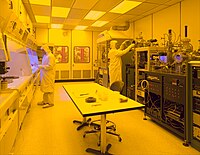
Photo from wikipedia
We report a simple, inexpensive and rapid method for fabrication of a stable and transparent superhydrophobic (TSHB) surface and its reversible transition to a transparent superhydrophilic (TSHL) surface. We provide… Click to show full abstract
We report a simple, inexpensive and rapid method for fabrication of a stable and transparent superhydrophobic (TSHB) surface and its reversible transition to a transparent superhydrophilic (TSHL) surface. We provide a mechanistic understanding of the superhydrophobicity and superhydrophilicity and the reversible transition. The proposed TSHB surface was created by candle sooting a partially cured n-hexane + PDMS surface followed by washing with DI water. The nano/microscopic grooved structures created on the surface conforms Cassie – Baxter state and thus gives rise to superhydrophobicity (water contact angle (WCA) = 161° ± 1°). The TSHB surface when subjected to oxygen plasma develops -OH bonds on the surface thus gets transformed into a TSHL surface (WCA < 1°). Both surface chemistry and surface morphology play important roles for the superhydrophobic to superhydrophilic transition. In the Cassie – Baxter relation for a composite surface, due to the capillary spreading of liquid in the nano/micro grooves, both θ1, θ2 = 0, thus giving rise to complete wetting. Rapid recovery of superhydrophobicity from superhydrophilicity was achieved by heating the TSHL surface at 150 °C for 30 min, due to a much faster adsorption of the -OH bonds into the PDMS. Thus it is possible to achieve reversible transition from TSHB to TSHL and vice versa by exposing to oxygen plasma and heat, respectively.
Journal Title: Scientific Reports
Year Published: 2018
Link to full text (if available)
Share on Social Media: Sign Up to like & get
recommendations!